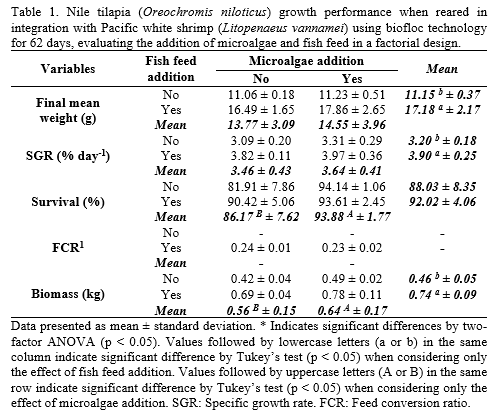EFFECTS OF MICROALGAE ADDITION AND FISH FEED SUPPLEMENTATION IN THE INTEGRATED REARING OF PACIFIC WHITE SHRIMP AND NILE TILAPIA USING BIOFLOC TECHNOLOGY
Introduction
The integration of different species aims at optimizing the use of nutrients generated by a primary fed species by employing other species that can take advantage of the excess nutrients, thus improving the use of resources of the overall production system (Chopin et al., 2001). Two species with the potential to be integrated are Pacific white shrimp (Litopenaeus vannamei) and Nile tilapia (Oreochromis niloticus). Poli et al. (2019) evaluated different Nile tilapia densities (10, 20, 30% of the biomass relative to the shrimp biomass) and found gains in yield and nutrient recovery, along with a reduction in the sludge: biomass relationship as the fish densities increased. In this work , the fish were fed at the rate of 1% of their biomass and the feed conversion ratio (FCR) observed by the authors was 0.2, indicating a relevant contribution of the bioflocs in the nutrition of the fish. However, there are no studies assessing if reared fish without feed supplementation can still maintain adequate performances impacting the overall integrated system, which would allow a reduction in the system inputs.
The microalgae Scenedesmus obliquus is freshwater green algae rich in protein and lipid contents, in addition to the carotenoid lutein. Its inoculation along with Chlorella sp. in a biofloc system benefitted the immune system of the fish (Jung et al., 2017). As consequence, the inoculation of microalgae species in biofloc-based integrated systems may enhance the biofloc attractiveness and nutritional composition, increasing natural food consumption by the fish and improving their growth performance.
Therefore, this study evaluated the supplementation of S. obliquus and fish feed in a Nile tilapia and Pacific white shrimp integrated system using biofloc technology and their effects on growth performance, production of solids and water microbiology
Material and methods
A two-factor 62-day experiment was conducted, in which each factor had two levels, addition or no addition of the microalgae Scenedesmus obliquus (5 mg L-1 twice a week) and the provision or no provision of fish feed (1% of the fish biomass), adding up to four treatments that were evaluated in quadruplicate. In all cases, shrimp were fed four times a day, according to a feeding table. The experimental units consisted of 800 L (useful volume) tanks for the shrimp and 90 L (useful volume) tanks for the tilapia, maintained under continuous recirculation. The shrimp (2.16 ± 0.01 g) were stocked under a density of 400 shrimp m-3 (320 shrimp tank-1) and the fish (1.53 ± 0.12 g) were stocked under a density of 522 fish m-3 (47 fish tank-1). Growth performance, sludge production and water microbiology were evaluated.
Results and discussion
Shrimp achieved a final mean weight of 12.1 ± 0.6 g and a survival of 78.3 ± 7.1%, with no significant differences between treatments. Fish that were fed exhibited final mean weight and final biomass 58% higher when compared with unfed fish. Fish survival was higher in treatments with the addition of microalgae (93.9 ± 1.8%) compared with the treatments of no microalgae addition (86.2 ± 7.6%). Fish final biomass was also 14% higher when microalgae was added (Tabela 1) . The overall system yield was higher in the treatments with the provision of fish feed (4.2 ± 0.2 kg m-3) compared with no addition (3.9 ± 0.2 kg m-3). Sludge production did not differ significantly between treatments (1.0 ± 0.1 kg tank -1 ), the same occurring with the count of total heterotrophic bacteria and Vibrio .
Data presented as mean ± standard deviation. * Indicates significant differences by two-factor ANOVA (p < 0.05). Values followed by lowercase letters (a or b) in the same column indicate significant difference by Tukey’s test (p < 0.05) when considering only the effect of fish feed addition. Values followed by uppercase letters (A or B) in the same row indicate significant difference by Tukey’s test (p < 0.05) when considering only the effect of microalgae addition. SGR: Specific growth rate. FCR: Feed conversion ratio.
Conclusion
Th is work suggest that fish feed supplementation at the rate of 1% of the biomass improved fish growth performance and system yield, without affecting sludge production and water microbiology. The addition of S. obliquus under the concentration of 5 mg L-1 tank-1 twice a week improved fish survival and final biomass. However, it did not significantly affect the overall system performance, sludge production and water microbiology.
Financial support:
Aquavitae project (Horizon 2020, grant number 818173).
References
Chopin, T., Buschmann , A.H., Halling , C., Troell , M., Kautsky, N., Neori , A., Kraemer , G.P., Zertuche ‐González, J.A., Yarish , C., Neefus , C., 2001. Integrating seaweeds into marine aquaculture systems: A key toward sustainability . J. Phycol. 37, 975–986.
Poli, M.A., Legarda, E.C., Lorenzo, M.A., Martins, M.A., Vieira, F.N., 2019. Pacific white shrimp and Nile tilapia integrated in a biofloc system under different fish-stocking densities. Aquaculture, 498: 83-89.
Jung, J.Y., Damusaru , J.H., Park, Y., Kim, K., Seong, M., Je, H.W., Kim, S., Bai, S.C., 2017. Autotrophic biofloc technology system (ABFT) using Chlorella vulgaris and Scenedesmus obliquus positively affects performance of Nile tilapia (Oreochromis niloticus). Algal Res. 27, 259–264.

